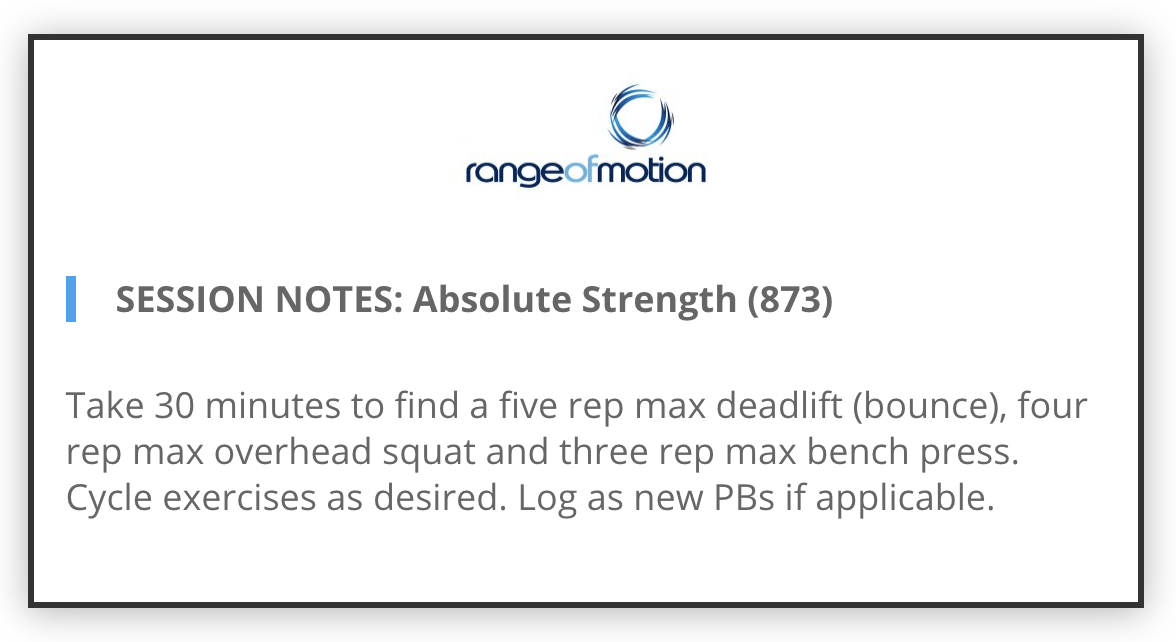
SESSION NOTES: Absolute Strength (873)
Take 30 minutes to find a five rep max deadlift (touch and go), four rep max overhead squat and three rep max bench press. Cycle exercises as desired. Log as new PBs if applicable.
Programming Science:
The three main elements of powerlifting are used, a squat based movement, a pull based movement (either deadlift/hip hinge or upper body pulling), and a press based movement.
Different variations of these movement types are programmed to build adaptability.
Usually, absolute strength is best trained by resetting repetitions for movements where a ‘bounce’ can be used. This forces the development of absolute strength rather than just relying on the stretch-shorten cycle (the elastic energy stored in the muscles). However, in this session, we are looking to build and develop this stretch-shorten cycle, which introduces an element of plyometric power production.
The ‘touch and go’ nature of these movements also build time under tension, which has a considerable metabolic effect.
The ability to cycle between exercises as you choose allows you to rest as much as possible between each set of the same type of exercise, while still being mindful of time efficiency. The 30 minute time cap gives an element of urgency, but is also a time efficient way of training as you’re able to include lighter warm-up weights in your training time.
Over time in this style of session, the reps will follow a pattern of five, four, three, two rep maxes. Knowing this pattern will allow you to increase weight each time these movements are completed. These sessions are interspersed evenly with other session types designed to build absolute strength.
Health and Body Composition Benefits:
Resistance training (using your muscles to lift heavy weights, either external weights or yourself) makes you stronger. Strength is one of the greatest predictors of both your lifespan (how long you live) and your healthspan (how long you live in a healthy state).
Resistance training like this will also improve your flexibility (by going through a full range of motion), posture and coordination. It will also build stability around your joints and spine to give you a healthy musculo-skeletal system and reduce joint and back pain.
The session will minimise losses in bone mineral density and will improve your balance. Strength and balance are the two strongest predictors of falls later in life, so this is an effective way to train fall prevention, and insure your independence into old age.
As a result of this style of session, you will experience changes in blood chemistry, including favourable effects on cholesterol, blood glucose, triglyceride and lipid levels.
This session increases your lean muscle mass and muscle fibre size. Muscle is a metabolically active tissue, so increasing it will maximise how much energy your body burns at rest. This makes it an effective session to reach healthy levels of body fat, both visceral fat (around the organs) and subcutaneous fat (under your skin). After this session, your body will go through a prolonged state of ‘EPOC’ (excess post- exercise oxygen consumption), meaning you’ll continue burning energy long after you finish training – further aiding healthy body composition.
Performance Benefits:
The heavy levels of resistance in this session are designed to increase your strength – increasing both your one rep max, and your ability to lift submaximal weights. By being stronger, you can lift more weight, and you will be able to lift submaximal weights faster and for higher reps because they’ll be at a lower percentage of your max.
As strength is an element of power, getting stronger will also improve your ability to move faster – beneficial for more power-based, explosive movements (like Olympic lifting). The ‘bouncing’ or ‘rebounding’ of reps will build the stretch-shorten cycle which is particularly useful in developing this speed and power.
This session will also improve the efficiency of your fast-twitch muscle fibres (those responsible for lifting heavy and fast), and will improve your neuromuscular efficiency (your ability to turn on a very high percentage of your muscle fibres).
Strategy:
The first ten minutes should see you quickly building up to moderate weights, cycling between each movement, adding weight as you go. In the second ten minutes, begin to build to heavy weights that require considerable effort. In the final ten minutes, aim for two sets of each movement, both of which should be very heavy.
The rep scheme in this session reduces from the previous time you completed this movement in a ‘30 minutes to find an ‘x’ rep max’ absolute strength session by one rep, meaning you should aim to increase from the previous time you did each of these movements.
You should complete around five sets of each movement that you would classify as ‘heavy’.
How it Should Feel:
From the 15 minute mark, each exercise should be feeling heavy, progressing to ‘very heavy’ by the 20 minute mark. The final two sets of each exercise should feel like a max effort.
Scaling Guidelines:
The preference with scaling for this is to keep the range of motion and reduce weight. Modify around injuries with exercises as close as possible to the stimulus of the movement you’re modifying.
Common Mistakes:
Starting too slow and not leaving enough time for the really heavy lifts in the final ten minutes.
This is not a ‘testing’ session (like if you were just building to a new one rep max), but a training session (that is, it’s designed to make you stronger, not to test your strength). As such, you should be completing enough sets at a heavy weight to elicit an increase in strength (at least five heavy sets for each movement).





